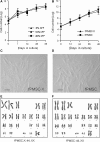Establishment of a xeno-free culture system that preserves the characteristics of placenta mesenchymal stem cells
- PMID: 24997581
- PMCID: PMC4545438
- DOI: 10.1007/s10616-014-9725-0
Establishment of a xeno-free culture system that preserves the characteristics of placenta mesenchymal stem cells
Abstract
Although stem cells are promising candidates for cell replacement therapies, the vast majority are derived using animal sera, which has risk of being contaminated by animal viruses or toxins. To overcome these potential problems, we initially established multiple lines of stem cells from first-trimester human placenta (fPMSC), which were cultivated using human follicular fluid (hFF) instead of fetal bovine serum (FBS). FF provides a very important microenvironment for the development of oocytes. No differences were found in the general morphology, growth rate, karyotype, gene and surface expressions between placental MSCs cultured in 5 % hFF-supplemented medium (fPMSC-X) or 10 % FBS-supplemented medium (fPMSC). Differentiation experiments confirmed similar levels of potency in cells grown in either condition. Since hFF preserved the unique features of the stem cells and is free from potential pathogens, it should be considered as the main culture medium supplement for the propagation of human stem cells for clinical applications.
Figures




References
-
- Attaran M, Pasqualotto E, Falcone T, Goldberg JM, Miller KF, Agarwal A, Sharma Rk. The effect of follicular fluid reactive oxygen species on the outcome of in vitro fertilization. Int J Fertil Womens Med. 2000;45:314–320. - PubMed
-
- Battula VL, Bareiss PM, Treml S, Conrad S, Albert I, Hojak S, Abele H, Schewe B, Just L, Skutella T, Bühring HJ. Human placenta and bone marrow derived MSC cultured in serum-free, b-FGF-containing medium express cell surface frizzled-9 and SSEA-4 and give rise to multilineage differentiation. Differentiation. 2007;75:279–291. doi: 10.1111/j.1432-0436.2006.00139.x. - DOI - PubMed
LinkOut - more resources
Full Text Sources
Other Literature Sources

